Business Research Project: Director Pay vs. Company Profitability
VerifiedAdded on 2020/03/23
|22
|4343
|638
Project
AI Summary
This business research project examines the relationship between director remuneration and company profitability within the top 50 Australian companies over three financial years (2014-2016). The research investigates the extent to which director pay is associated with firm profit, using annual report data. It incorporates agency theory, resource dependency theory, and corporate law to establish a theoretical framework. The methodology involves data collection from annual reports, descriptive analysis, and correlation analysis to test the null hypothesis that there is no association between director remuneration and firm profits. The findings indicate that, across the three years, the remuneration earned by directors does not depend on the performance of the company. The project also reviews board diversity of expertise and heterogeneity, identifying gaps in the existing literature and concluding that the directors' remuneration does not influence company profit. The research aims to offer insights into corporate governance and financial performance within the Australian context.
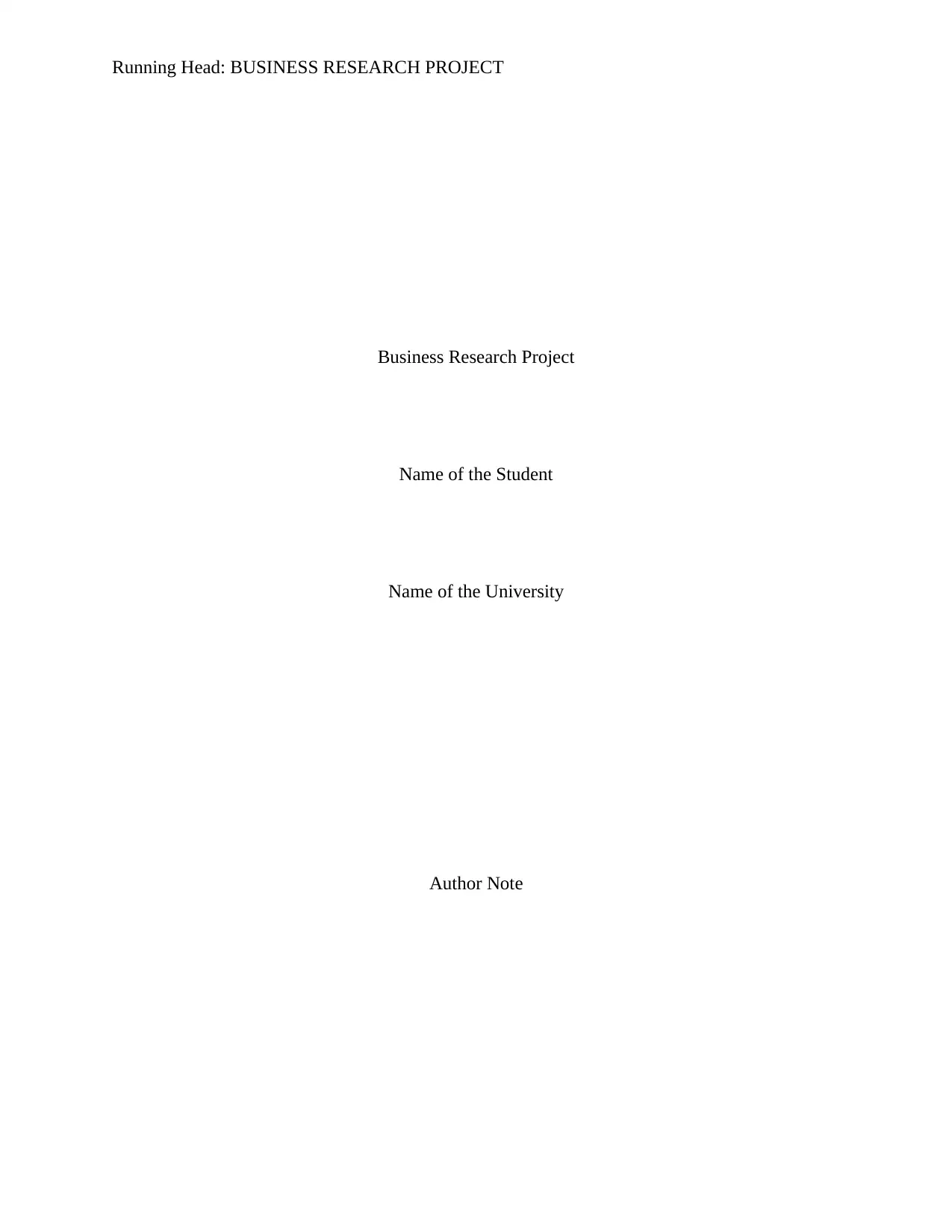
Running Head: BUSINESS RESEARCH PROJECT
Business Research Project
Name of the Student
Name of the University
Author Note
Business Research Project
Name of the Student
Name of the University
Author Note
Paraphrase This Document
Need a fresh take? Get an instant paraphrase of this document with our AI Paraphraser
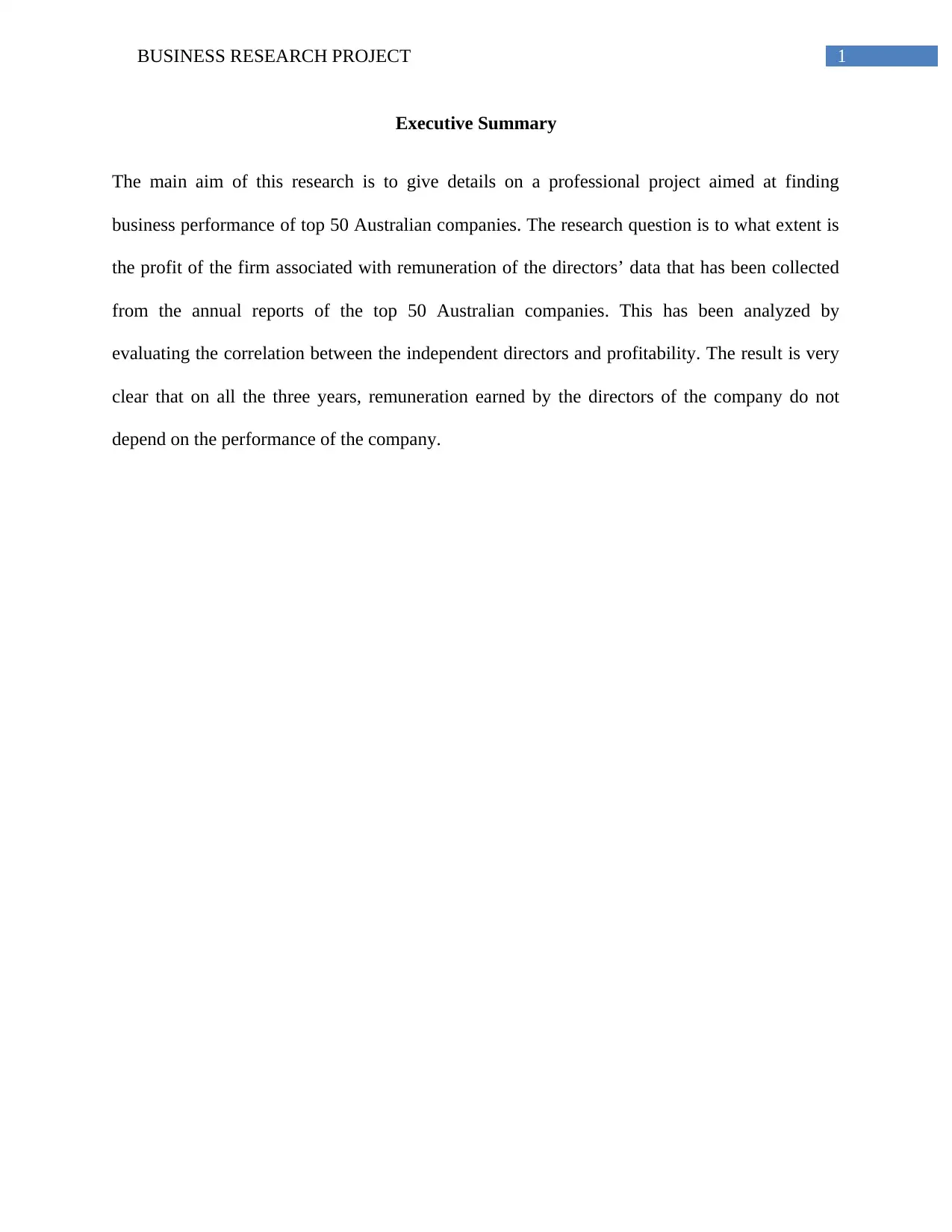
1BUSINESS RESEARCH PROJECT
Executive Summary
The main aim of this research is to give details on a professional project aimed at finding
business performance of top 50 Australian companies. The research question is to what extent is
the profit of the firm associated with remuneration of the directors’ data that has been collected
from the annual reports of the top 50 Australian companies. This has been analyzed by
evaluating the correlation between the independent directors and profitability. The result is very
clear that on all the three years, remuneration earned by the directors of the company do not
depend on the performance of the company.
Executive Summary
The main aim of this research is to give details on a professional project aimed at finding
business performance of top 50 Australian companies. The research question is to what extent is
the profit of the firm associated with remuneration of the directors’ data that has been collected
from the annual reports of the top 50 Australian companies. This has been analyzed by
evaluating the correlation between the independent directors and profitability. The result is very
clear that on all the three years, remuneration earned by the directors of the company do not
depend on the performance of the company.
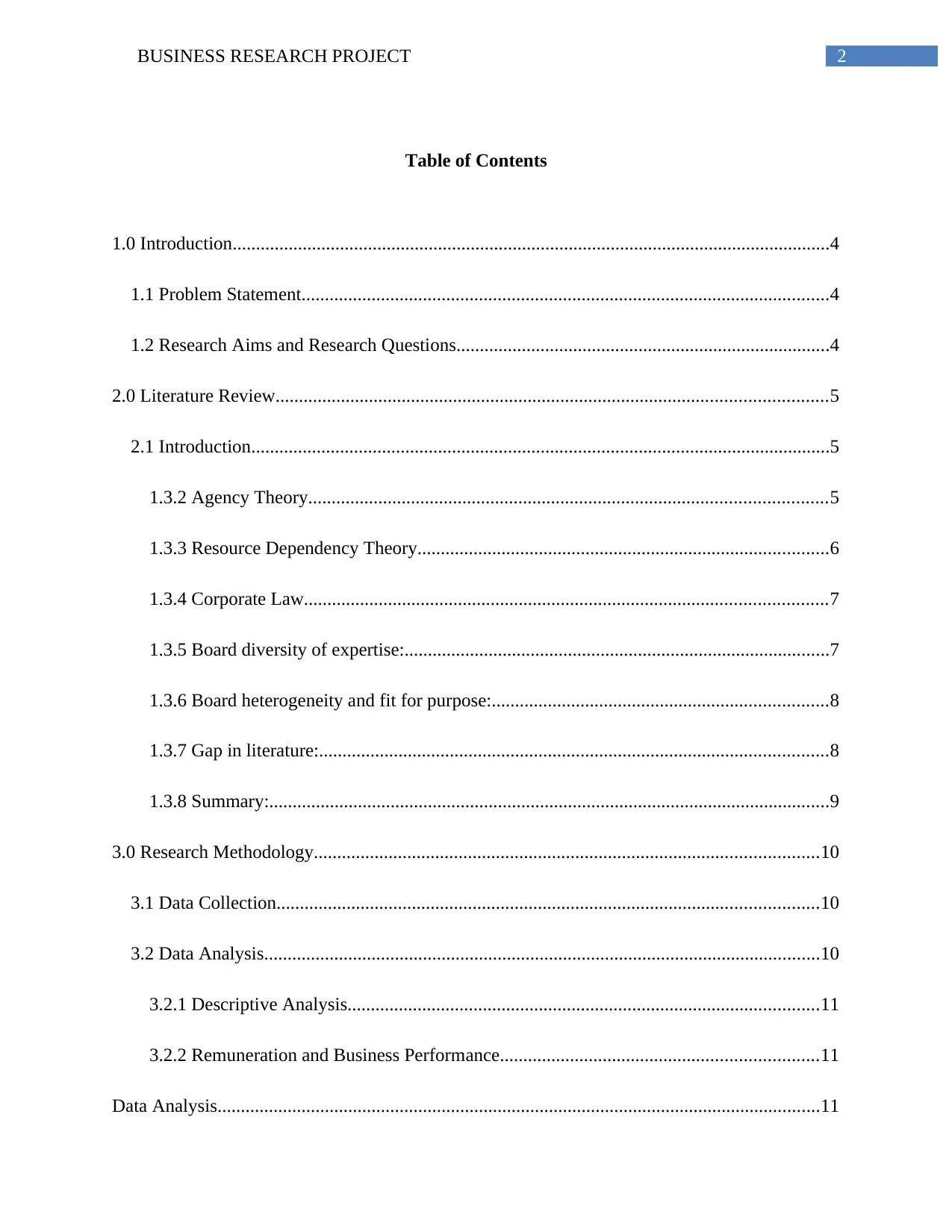
2BUSINESS RESEARCH PROJECT
Table of Contents
1.0 Introduction................................................................................................................................4
1.1 Problem Statement.................................................................................................................4
1.2 Research Aims and Research Questions................................................................................4
2.0 Literature Review......................................................................................................................5
2.1 Introduction............................................................................................................................5
1.3.2 Agency Theory...............................................................................................................5
1.3.3 Resource Dependency Theory........................................................................................6
1.3.4 Corporate Law................................................................................................................7
1.3.5 Board diversity of expertise:...........................................................................................7
1.3.6 Board heterogeneity and fit for purpose:........................................................................8
1.3.7 Gap in literature:.............................................................................................................8
1.3.8 Summary:........................................................................................................................9
3.0 Research Methodology............................................................................................................10
3.1 Data Collection....................................................................................................................10
3.2 Data Analysis.......................................................................................................................10
3.2.1 Descriptive Analysis.....................................................................................................11
3.2.2 Remuneration and Business Performance....................................................................11
Data Analysis.................................................................................................................................11
Table of Contents
1.0 Introduction................................................................................................................................4
1.1 Problem Statement.................................................................................................................4
1.2 Research Aims and Research Questions................................................................................4
2.0 Literature Review......................................................................................................................5
2.1 Introduction............................................................................................................................5
1.3.2 Agency Theory...............................................................................................................5
1.3.3 Resource Dependency Theory........................................................................................6
1.3.4 Corporate Law................................................................................................................7
1.3.5 Board diversity of expertise:...........................................................................................7
1.3.6 Board heterogeneity and fit for purpose:........................................................................8
1.3.7 Gap in literature:.............................................................................................................8
1.3.8 Summary:........................................................................................................................9
3.0 Research Methodology............................................................................................................10
3.1 Data Collection....................................................................................................................10
3.2 Data Analysis.......................................................................................................................10
3.2.1 Descriptive Analysis.....................................................................................................11
3.2.2 Remuneration and Business Performance....................................................................11
Data Analysis.................................................................................................................................11
⊘ This is a preview!⊘
Do you want full access?
Subscribe today to unlock all pages.

Trusted by 1+ million students worldwide
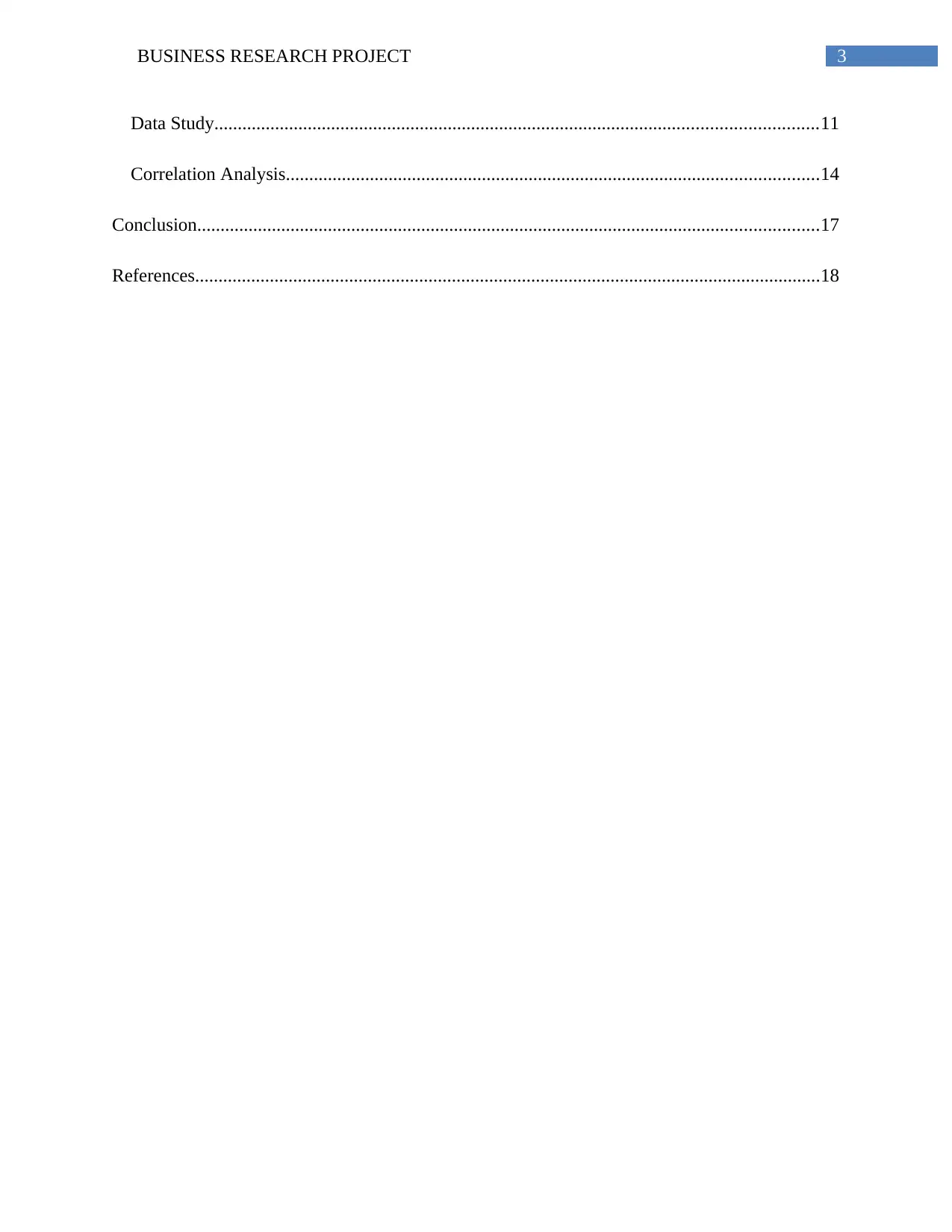
3BUSINESS RESEARCH PROJECT
Data Study.................................................................................................................................11
Correlation Analysis..................................................................................................................14
Conclusion.....................................................................................................................................17
References......................................................................................................................................18
Data Study.................................................................................................................................11
Correlation Analysis..................................................................................................................14
Conclusion.....................................................................................................................................17
References......................................................................................................................................18
Paraphrase This Document
Need a fresh take? Get an instant paraphrase of this document with our AI Paraphraser
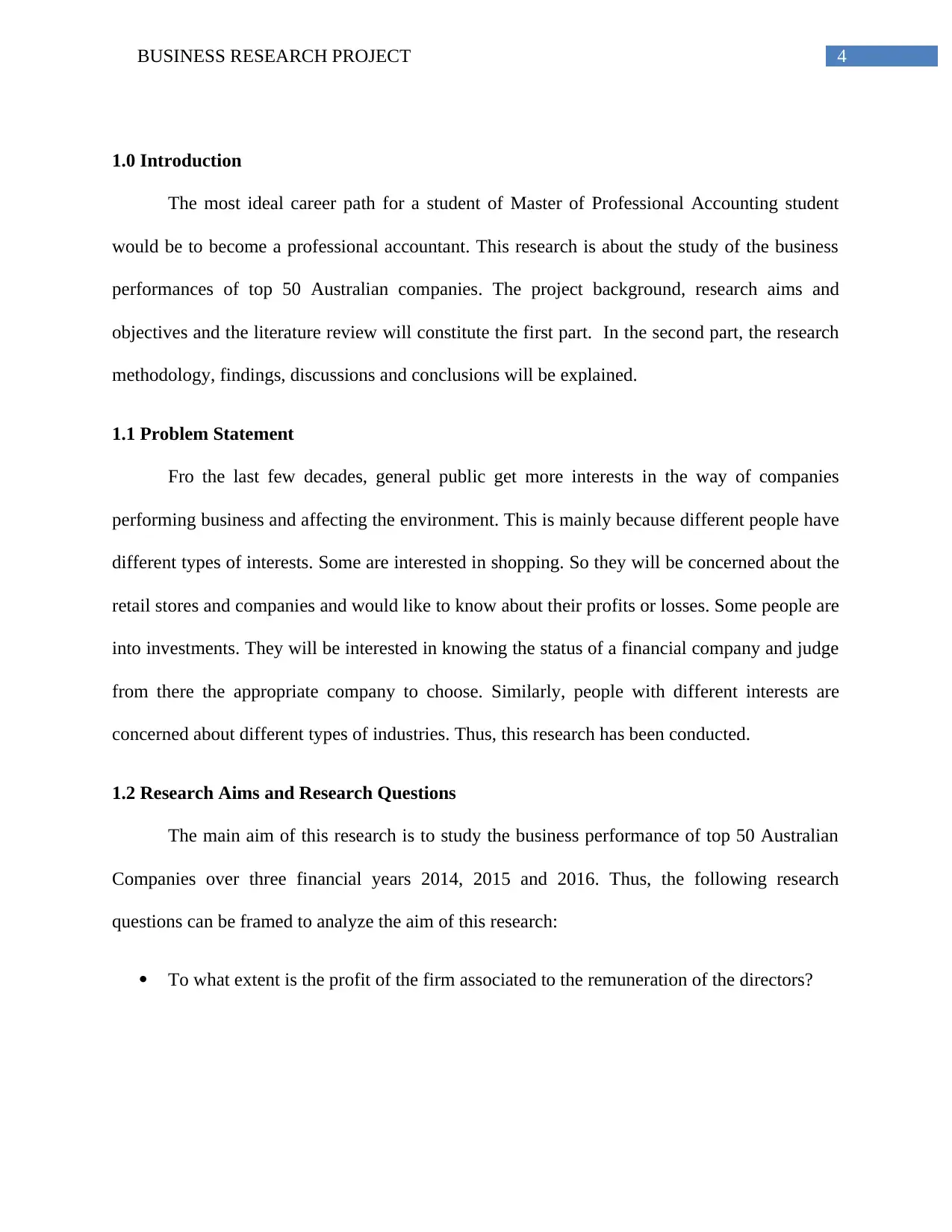
4BUSINESS RESEARCH PROJECT
1.0 Introduction
The most ideal career path for a student of Master of Professional Accounting student
would be to become a professional accountant. This research is about the study of the business
performances of top 50 Australian companies. The project background, research aims and
objectives and the literature review will constitute the first part. In the second part, the research
methodology, findings, discussions and conclusions will be explained.
1.1 Problem Statement
Fro the last few decades, general public get more interests in the way of companies
performing business and affecting the environment. This is mainly because different people have
different types of interests. Some are interested in shopping. So they will be concerned about the
retail stores and companies and would like to know about their profits or losses. Some people are
into investments. They will be interested in knowing the status of a financial company and judge
from there the appropriate company to choose. Similarly, people with different interests are
concerned about different types of industries. Thus, this research has been conducted.
1.2 Research Aims and Research Questions
The main aim of this research is to study the business performance of top 50 Australian
Companies over three financial years 2014, 2015 and 2016. Thus, the following research
questions can be framed to analyze the aim of this research:
To what extent is the profit of the firm associated to the remuneration of the directors?
1.0 Introduction
The most ideal career path for a student of Master of Professional Accounting student
would be to become a professional accountant. This research is about the study of the business
performances of top 50 Australian companies. The project background, research aims and
objectives and the literature review will constitute the first part. In the second part, the research
methodology, findings, discussions and conclusions will be explained.
1.1 Problem Statement
Fro the last few decades, general public get more interests in the way of companies
performing business and affecting the environment. This is mainly because different people have
different types of interests. Some are interested in shopping. So they will be concerned about the
retail stores and companies and would like to know about their profits or losses. Some people are
into investments. They will be interested in knowing the status of a financial company and judge
from there the appropriate company to choose. Similarly, people with different interests are
concerned about different types of industries. Thus, this research has been conducted.
1.2 Research Aims and Research Questions
The main aim of this research is to study the business performance of top 50 Australian
Companies over three financial years 2014, 2015 and 2016. Thus, the following research
questions can be framed to analyze the aim of this research:
To what extent is the profit of the firm associated to the remuneration of the directors?
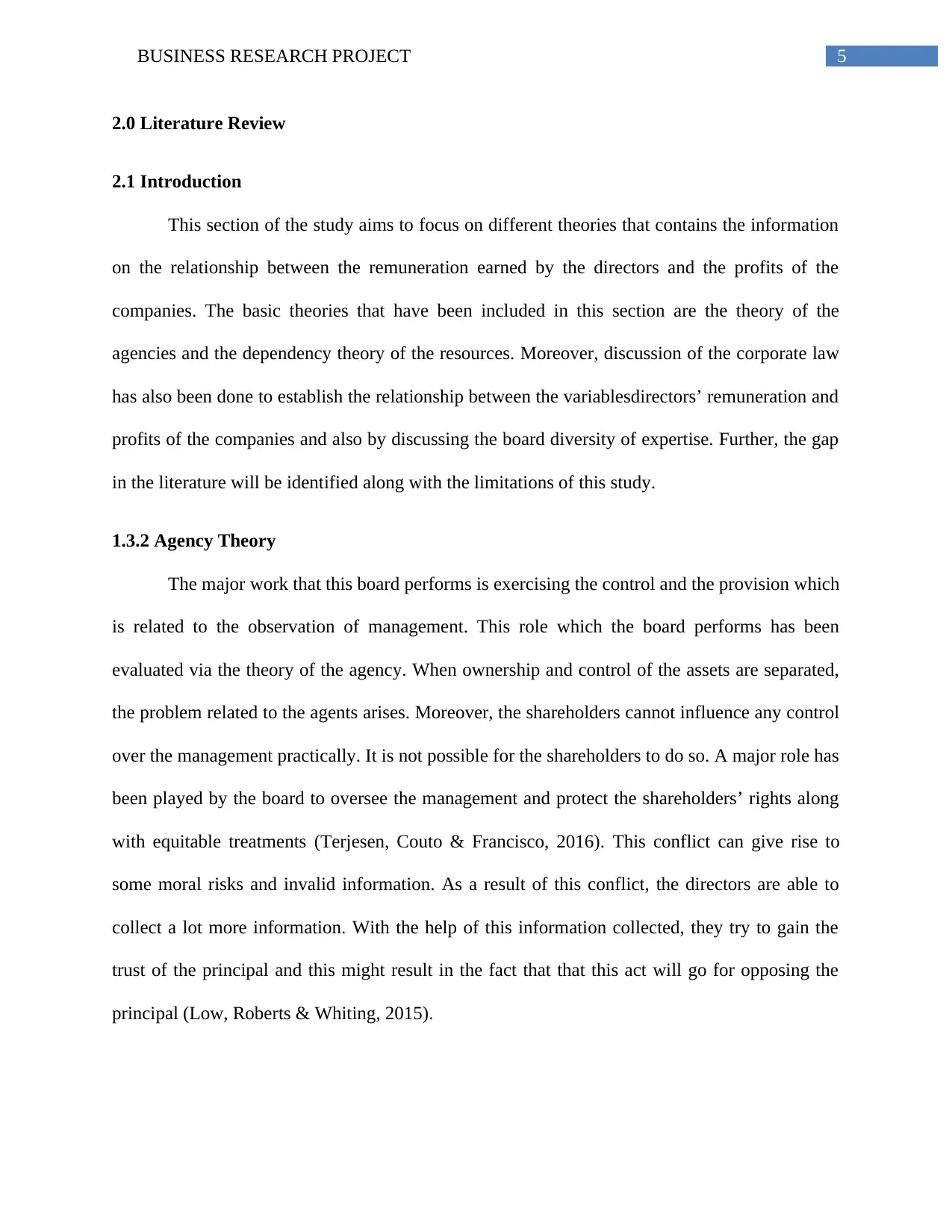
5BUSINESS RESEARCH PROJECT
2.0 Literature Review
2.1 Introduction
This section of the study aims to focus on different theories that contains the information
on the relationship between the remuneration earned by the directors and the profits of the
companies. The basic theories that have been included in this section are the theory of the
agencies and the dependency theory of the resources. Moreover, discussion of the corporate law
has also been done to establish the relationship between the variablesdirectors’ remuneration and
profits of the companies and also by discussing the board diversity of expertise. Further, the gap
in the literature will be identified along with the limitations of this study.
1.3.2 Agency Theory
The major work that this board performs is exercising the control and the provision which
is related to the observation of management. This role which the board performs has been
evaluated via the theory of the agency. When ownership and control of the assets are separated,
the problem related to the agents arises. Moreover, the shareholders cannot influence any control
over the management practically. It is not possible for the shareholders to do so. A major role has
been played by the board to oversee the management and protect the shareholders’ rights along
with equitable treatments (Terjesen, Couto & Francisco, 2016). This conflict can give rise to
some moral risks and invalid information. As a result of this conflict, the directors are able to
collect a lot more information. With the help of this information collected, they try to gain the
trust of the principal and this might result in the fact that that this act will go for opposing the
principal (Low, Roberts & Whiting, 2015).
2.0 Literature Review
2.1 Introduction
This section of the study aims to focus on different theories that contains the information
on the relationship between the remuneration earned by the directors and the profits of the
companies. The basic theories that have been included in this section are the theory of the
agencies and the dependency theory of the resources. Moreover, discussion of the corporate law
has also been done to establish the relationship between the variablesdirectors’ remuneration and
profits of the companies and also by discussing the board diversity of expertise. Further, the gap
in the literature will be identified along with the limitations of this study.
1.3.2 Agency Theory
The major work that this board performs is exercising the control and the provision which
is related to the observation of management. This role which the board performs has been
evaluated via the theory of the agency. When ownership and control of the assets are separated,
the problem related to the agents arises. Moreover, the shareholders cannot influence any control
over the management practically. It is not possible for the shareholders to do so. A major role has
been played by the board to oversee the management and protect the shareholders’ rights along
with equitable treatments (Terjesen, Couto & Francisco, 2016). This conflict can give rise to
some moral risks and invalid information. As a result of this conflict, the directors are able to
collect a lot more information. With the help of this information collected, they try to gain the
trust of the principal and this might result in the fact that that this act will go for opposing the
principal (Low, Roberts & Whiting, 2015).
⊘ This is a preview!⊘
Do you want full access?
Subscribe today to unlock all pages.

Trusted by 1+ million students worldwide
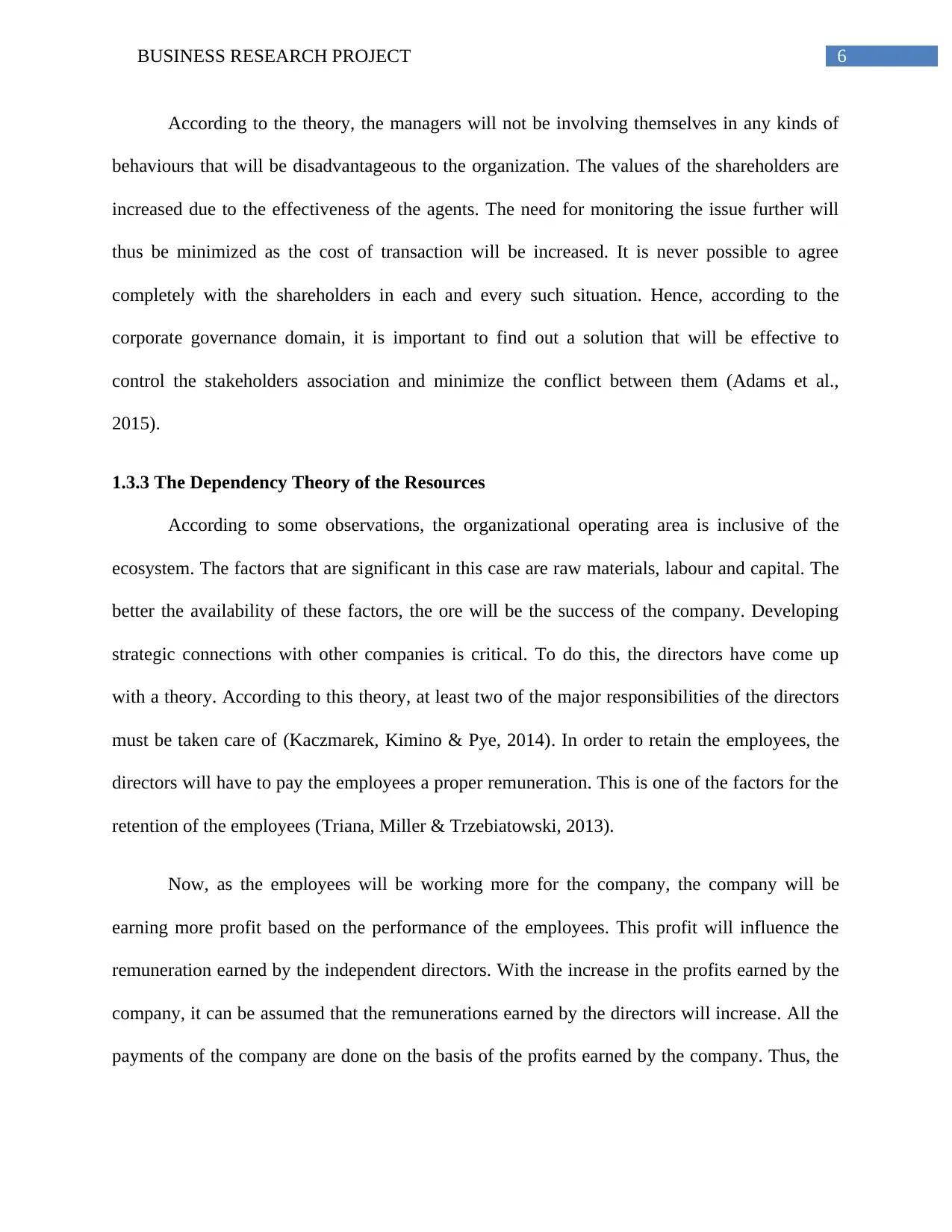
6BUSINESS RESEARCH PROJECT
According to the theory, the managers will not be involving themselves in any kinds of
behaviours that will be disadvantageous to the organization. The values of the shareholders are
increased due to the effectiveness of the agents. The need for monitoring the issue further will
thus be minimized as the cost of transaction will be increased. It is never possible to agree
completely with the shareholders in each and every such situation. Hence, according to the
corporate governance domain, it is important to find out a solution that will be effective to
control the stakeholders association and minimize the conflict between them (Adams et al.,
2015).
1.3.3 The Dependency Theory of the Resources
According to some observations, the organizational operating area is inclusive of the
ecosystem. The factors that are significant in this case are raw materials, labour and capital. The
better the availability of these factors, the ore will be the success of the company. Developing
strategic connections with other companies is critical. To do this, the directors have come up
with a theory. According to this theory, at least two of the major responsibilities of the directors
must be taken care of (Kaczmarek, Kimino & Pye, 2014). In order to retain the employees, the
directors will have to pay the employees a proper remuneration. This is one of the factors for the
retention of the employees (Triana, Miller & Trzebiatowski, 2013).
Now, as the employees will be working more for the company, the company will be
earning more profit based on the performance of the employees. This profit will influence the
remuneration earned by the independent directors. With the increase in the profits earned by the
company, it can be assumed that the remunerations earned by the directors will increase. All the
payments of the company are done on the basis of the profits earned by the company. Thus, the
According to the theory, the managers will not be involving themselves in any kinds of
behaviours that will be disadvantageous to the organization. The values of the shareholders are
increased due to the effectiveness of the agents. The need for monitoring the issue further will
thus be minimized as the cost of transaction will be increased. It is never possible to agree
completely with the shareholders in each and every such situation. Hence, according to the
corporate governance domain, it is important to find out a solution that will be effective to
control the stakeholders association and minimize the conflict between them (Adams et al.,
2015).
1.3.3 The Dependency Theory of the Resources
According to some observations, the organizational operating area is inclusive of the
ecosystem. The factors that are significant in this case are raw materials, labour and capital. The
better the availability of these factors, the ore will be the success of the company. Developing
strategic connections with other companies is critical. To do this, the directors have come up
with a theory. According to this theory, at least two of the major responsibilities of the directors
must be taken care of (Kaczmarek, Kimino & Pye, 2014). In order to retain the employees, the
directors will have to pay the employees a proper remuneration. This is one of the factors for the
retention of the employees (Triana, Miller & Trzebiatowski, 2013).
Now, as the employees will be working more for the company, the company will be
earning more profit based on the performance of the employees. This profit will influence the
remuneration earned by the independent directors. With the increase in the profits earned by the
company, it can be assumed that the remunerations earned by the directors will increase. All the
payments of the company are done on the basis of the profits earned by the company. Thus, the
Paraphrase This Document
Need a fresh take? Get an instant paraphrase of this document with our AI Paraphraser
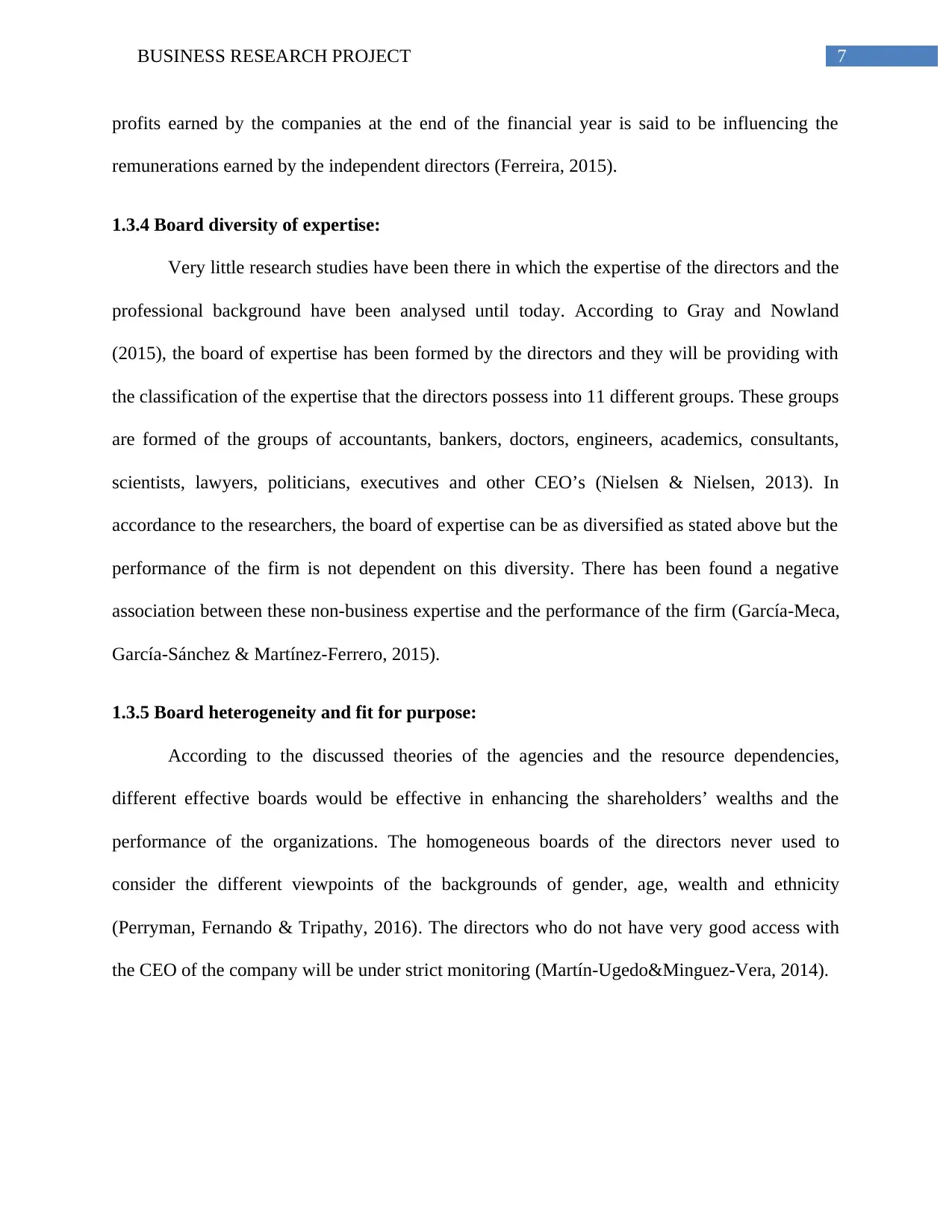
7BUSINESS RESEARCH PROJECT
profits earned by the companies at the end of the financial year is said to be influencing the
remunerations earned by the independent directors (Ferreira, 2015).
1.3.4 Board diversity of expertise:
Very little research studies have been there in which the expertise of the directors and the
professional background have been analysed until today. According to Gray and Nowland
(2015), the board of expertise has been formed by the directors and they will be providing with
the classification of the expertise that the directors possess into 11 different groups. These groups
are formed of the groups of accountants, bankers, doctors, engineers, academics, consultants,
scientists, lawyers, politicians, executives and other CEO’s (Nielsen & Nielsen, 2013). In
accordance to the researchers, the board of expertise can be as diversified as stated above but the
performance of the firm is not dependent on this diversity. There has been found a negative
association between these non-business expertise and the performance of the firm (García-Meca,
García-Sánchez & Martínez-Ferrero, 2015).
1.3.5 Board heterogeneity and fit for purpose:
According to the discussed theories of the agencies and the resource dependencies,
different effective boards would be effective in enhancing the shareholders’ wealths and the
performance of the organizations. The homogeneous boards of the directors never used to
consider the different viewpoints of the backgrounds of gender, age, wealth and ethnicity
(Perryman, Fernando & Tripathy, 2016). The directors who do not have very good access with
the CEO of the company will be under strict monitoring (Martín-Ugedo&Minguez-Vera, 2014).
profits earned by the companies at the end of the financial year is said to be influencing the
remunerations earned by the independent directors (Ferreira, 2015).
1.3.4 Board diversity of expertise:
Very little research studies have been there in which the expertise of the directors and the
professional background have been analysed until today. According to Gray and Nowland
(2015), the board of expertise has been formed by the directors and they will be providing with
the classification of the expertise that the directors possess into 11 different groups. These groups
are formed of the groups of accountants, bankers, doctors, engineers, academics, consultants,
scientists, lawyers, politicians, executives and other CEO’s (Nielsen & Nielsen, 2013). In
accordance to the researchers, the board of expertise can be as diversified as stated above but the
performance of the firm is not dependent on this diversity. There has been found a negative
association between these non-business expertise and the performance of the firm (García-Meca,
García-Sánchez & Martínez-Ferrero, 2015).
1.3.5 Board heterogeneity and fit for purpose:
According to the discussed theories of the agencies and the resource dependencies,
different effective boards would be effective in enhancing the shareholders’ wealths and the
performance of the organizations. The homogeneous boards of the directors never used to
consider the different viewpoints of the backgrounds of gender, age, wealth and ethnicity
(Perryman, Fernando & Tripathy, 2016). The directors who do not have very good access with
the CEO of the company will be under strict monitoring (Martín-Ugedo&Minguez-Vera, 2014).
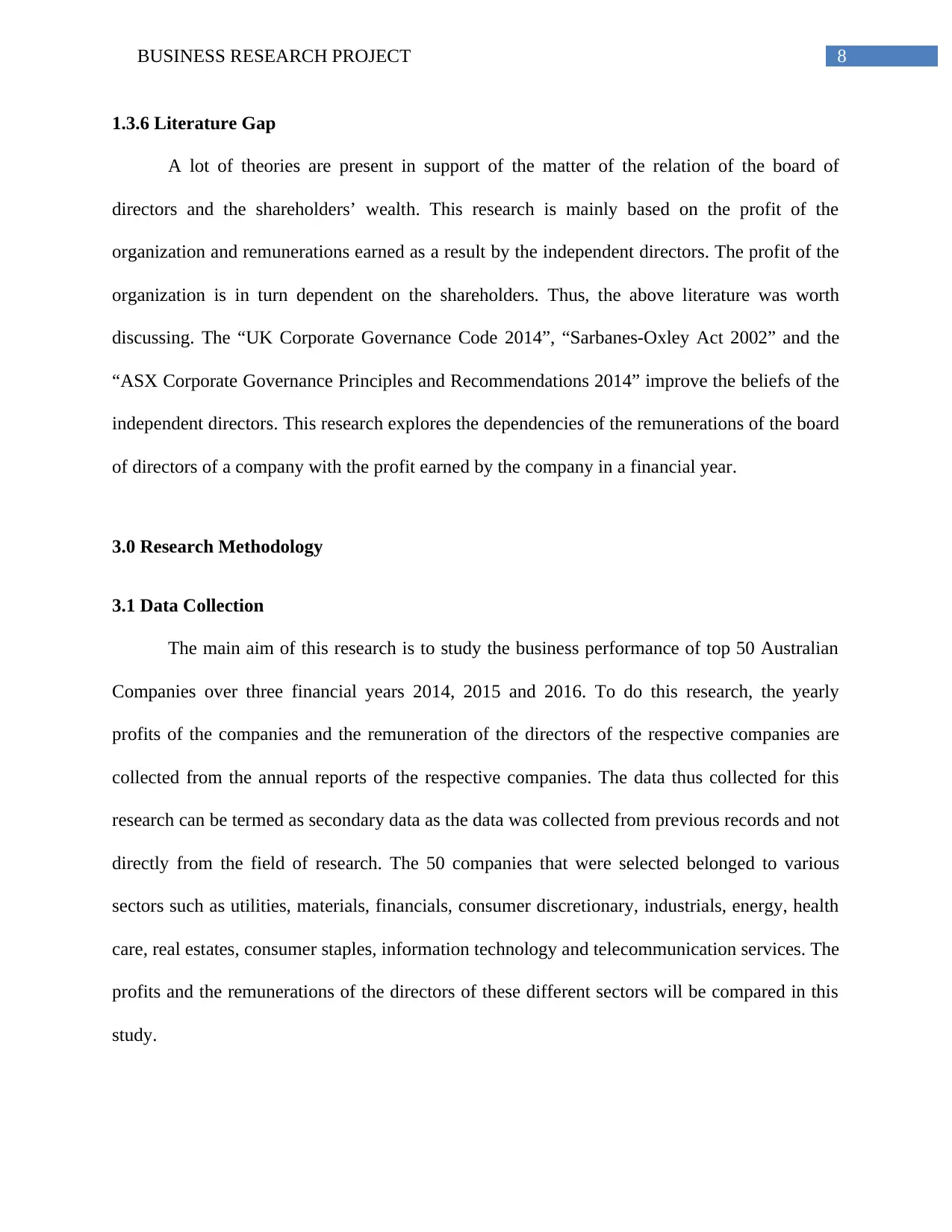
8BUSINESS RESEARCH PROJECT
1.3.6 Literature Gap
A lot of theories are present in support of the matter of the relation of the board of
directors and the shareholders’ wealth. This research is mainly based on the profit of the
organization and remunerations earned as a result by the independent directors. The profit of the
organization is in turn dependent on the shareholders. Thus, the above literature was worth
discussing. The “UK Corporate Governance Code 2014”, “Sarbanes-Oxley Act 2002” and the
“ASX Corporate Governance Principles and Recommendations 2014” improve the beliefs of the
independent directors. This research explores the dependencies of the remunerations of the board
of directors of a company with the profit earned by the company in a financial year.
3.0 Research Methodology
3.1 Data Collection
The main aim of this research is to study the business performance of top 50 Australian
Companies over three financial years 2014, 2015 and 2016. To do this research, the yearly
profits of the companies and the remuneration of the directors of the respective companies are
collected from the annual reports of the respective companies. The data thus collected for this
research can be termed as secondary data as the data was collected from previous records and not
directly from the field of research. The 50 companies that were selected belonged to various
sectors such as utilities, materials, financials, consumer discretionary, industrials, energy, health
care, real estates, consumer staples, information technology and telecommunication services. The
profits and the remunerations of the directors of these different sectors will be compared in this
study.
1.3.6 Literature Gap
A lot of theories are present in support of the matter of the relation of the board of
directors and the shareholders’ wealth. This research is mainly based on the profit of the
organization and remunerations earned as a result by the independent directors. The profit of the
organization is in turn dependent on the shareholders. Thus, the above literature was worth
discussing. The “UK Corporate Governance Code 2014”, “Sarbanes-Oxley Act 2002” and the
“ASX Corporate Governance Principles and Recommendations 2014” improve the beliefs of the
independent directors. This research explores the dependencies of the remunerations of the board
of directors of a company with the profit earned by the company in a financial year.
3.0 Research Methodology
3.1 Data Collection
The main aim of this research is to study the business performance of top 50 Australian
Companies over three financial years 2014, 2015 and 2016. To do this research, the yearly
profits of the companies and the remuneration of the directors of the respective companies are
collected from the annual reports of the respective companies. The data thus collected for this
research can be termed as secondary data as the data was collected from previous records and not
directly from the field of research. The 50 companies that were selected belonged to various
sectors such as utilities, materials, financials, consumer discretionary, industrials, energy, health
care, real estates, consumer staples, information technology and telecommunication services. The
profits and the remunerations of the directors of these different sectors will be compared in this
study.
⊘ This is a preview!⊘
Do you want full access?
Subscribe today to unlock all pages.

Trusted by 1+ million students worldwide
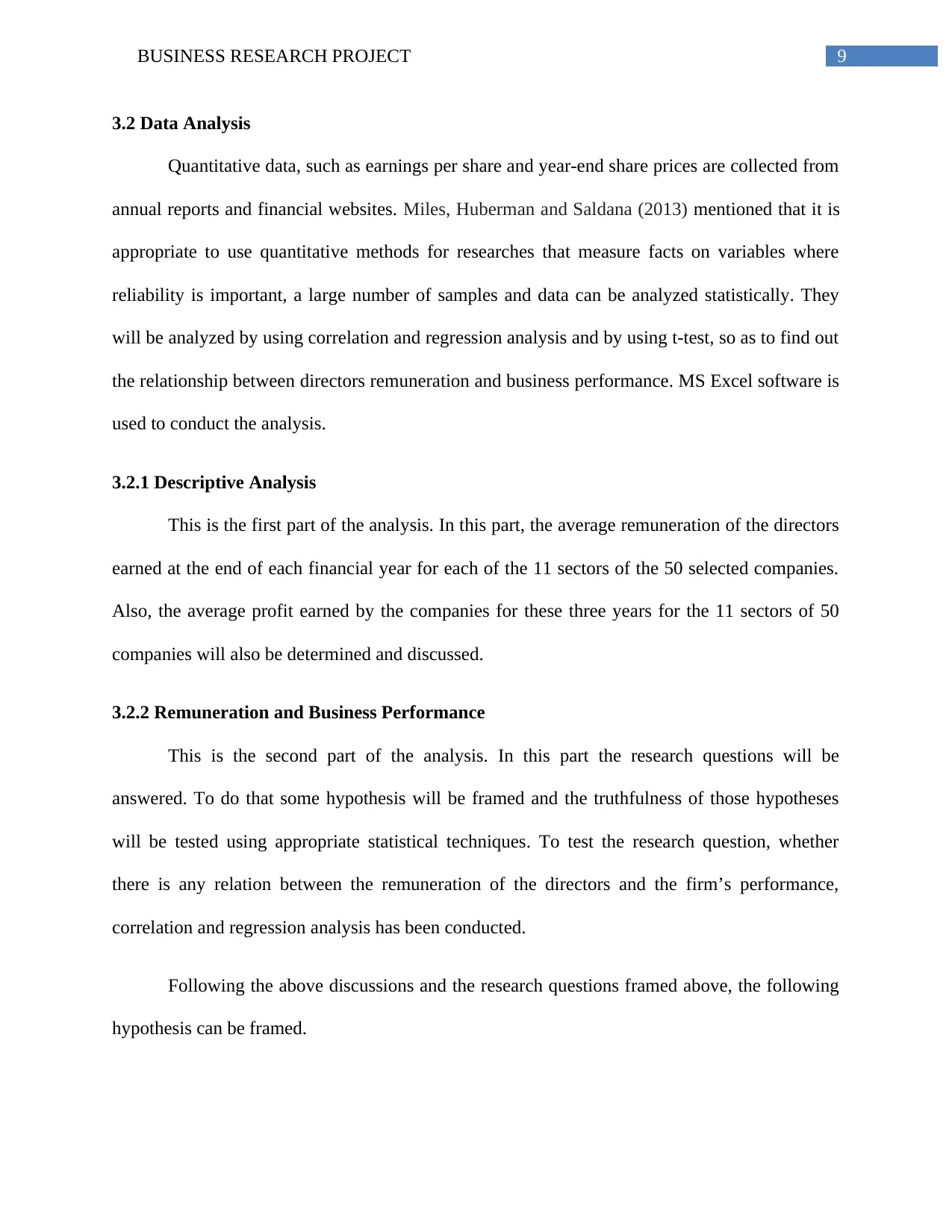
9BUSINESS RESEARCH PROJECT
3.2 Data Analysis
Quantitative data, such as earnings per share and year-end share prices are collected from
annual reports and financial websites. Miles, Huberman and Saldana (2013) mentioned that it is
appropriate to use quantitative methods for researches that measure facts on variables where
reliability is important, a large number of samples and data can be analyzed statistically. They
will be analyzed by using correlation and regression analysis and by using t-test, so as to find out
the relationship between directors remuneration and business performance. MS Excel software is
used to conduct the analysis.
3.2.1 Descriptive Analysis
This is the first part of the analysis. In this part, the average remuneration of the directors
earned at the end of each financial year for each of the 11 sectors of the 50 selected companies.
Also, the average profit earned by the companies for these three years for the 11 sectors of 50
companies will also be determined and discussed.
3.2.2 Remuneration and Business Performance
This is the second part of the analysis. In this part the research questions will be
answered. To do that some hypothesis will be framed and the truthfulness of those hypotheses
will be tested using appropriate statistical techniques. To test the research question, whether
there is any relation between the remuneration of the directors and the firm’s performance,
correlation and regression analysis has been conducted.
Following the above discussions and the research questions framed above, the following
hypothesis can be framed.
3.2 Data Analysis
Quantitative data, such as earnings per share and year-end share prices are collected from
annual reports and financial websites. Miles, Huberman and Saldana (2013) mentioned that it is
appropriate to use quantitative methods for researches that measure facts on variables where
reliability is important, a large number of samples and data can be analyzed statistically. They
will be analyzed by using correlation and regression analysis and by using t-test, so as to find out
the relationship between directors remuneration and business performance. MS Excel software is
used to conduct the analysis.
3.2.1 Descriptive Analysis
This is the first part of the analysis. In this part, the average remuneration of the directors
earned at the end of each financial year for each of the 11 sectors of the 50 selected companies.
Also, the average profit earned by the companies for these three years for the 11 sectors of 50
companies will also be determined and discussed.
3.2.2 Remuneration and Business Performance
This is the second part of the analysis. In this part the research questions will be
answered. To do that some hypothesis will be framed and the truthfulness of those hypotheses
will be tested using appropriate statistical techniques. To test the research question, whether
there is any relation between the remuneration of the directors and the firm’s performance,
correlation and regression analysis has been conducted.
Following the above discussions and the research questions framed above, the following
hypothesis can be framed.
Paraphrase This Document
Need a fresh take? Get an instant paraphrase of this document with our AI Paraphraser
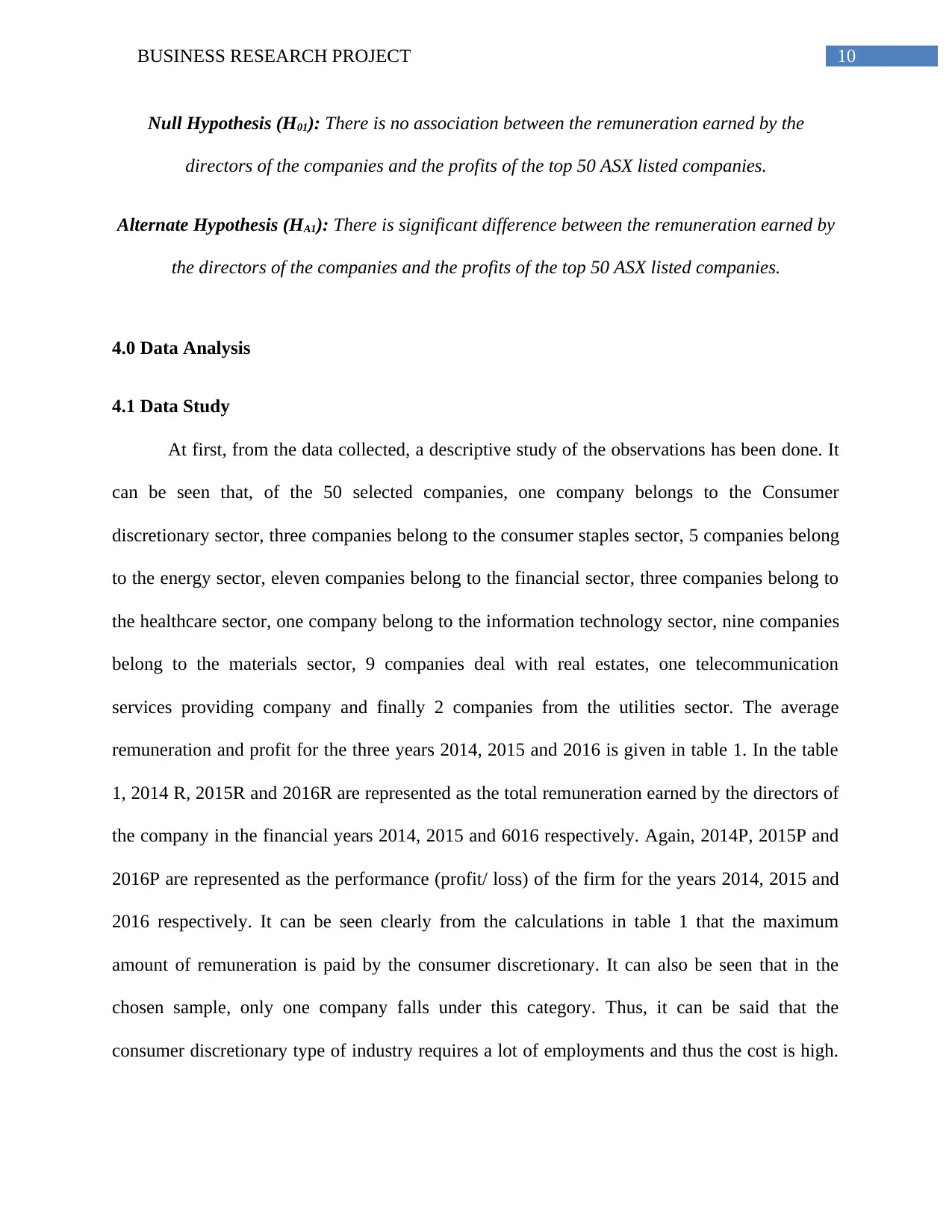
10BUSINESS RESEARCH PROJECT
Null Hypothesis (H01): There is no association between the remuneration earned by the
directors of the companies and the profits of the top 50 ASX listed companies.
Alternate Hypothesis (HA1): There is significant difference between the remuneration earned by
the directors of the companies and the profits of the top 50 ASX listed companies.
4.0 Data Analysis
4.1 Data Study
At first, from the data collected, a descriptive study of the observations has been done. It
can be seen that, of the 50 selected companies, one company belongs to the Consumer
discretionary sector, three companies belong to the consumer staples sector, 5 companies belong
to the energy sector, eleven companies belong to the financial sector, three companies belong to
the healthcare sector, one company belong to the information technology sector, nine companies
belong to the materials sector, 9 companies deal with real estates, one telecommunication
services providing company and finally 2 companies from the utilities sector. The average
remuneration and profit for the three years 2014, 2015 and 2016 is given in table 1. In the table
1, 2014 R, 2015R and 2016R are represented as the total remuneration earned by the directors of
the company in the financial years 2014, 2015 and 6016 respectively. Again, 2014P, 2015P and
2016P are represented as the performance (profit/ loss) of the firm for the years 2014, 2015 and
2016 respectively. It can be seen clearly from the calculations in table 1 that the maximum
amount of remuneration is paid by the consumer discretionary. It can also be seen that in the
chosen sample, only one company falls under this category. Thus, it can be said that the
consumer discretionary type of industry requires a lot of employments and thus the cost is high.
Null Hypothesis (H01): There is no association between the remuneration earned by the
directors of the companies and the profits of the top 50 ASX listed companies.
Alternate Hypothesis (HA1): There is significant difference between the remuneration earned by
the directors of the companies and the profits of the top 50 ASX listed companies.
4.0 Data Analysis
4.1 Data Study
At first, from the data collected, a descriptive study of the observations has been done. It
can be seen that, of the 50 selected companies, one company belongs to the Consumer
discretionary sector, three companies belong to the consumer staples sector, 5 companies belong
to the energy sector, eleven companies belong to the financial sector, three companies belong to
the healthcare sector, one company belong to the information technology sector, nine companies
belong to the materials sector, 9 companies deal with real estates, one telecommunication
services providing company and finally 2 companies from the utilities sector. The average
remuneration and profit for the three years 2014, 2015 and 2016 is given in table 1. In the table
1, 2014 R, 2015R and 2016R are represented as the total remuneration earned by the directors of
the company in the financial years 2014, 2015 and 6016 respectively. Again, 2014P, 2015P and
2016P are represented as the performance (profit/ loss) of the firm for the years 2014, 2015 and
2016 respectively. It can be seen clearly from the calculations in table 1 that the maximum
amount of remuneration is paid by the consumer discretionary. It can also be seen that in the
chosen sample, only one company falls under this category. Thus, it can be said that the
consumer discretionary type of industry requires a lot of employments and thus the cost is high.
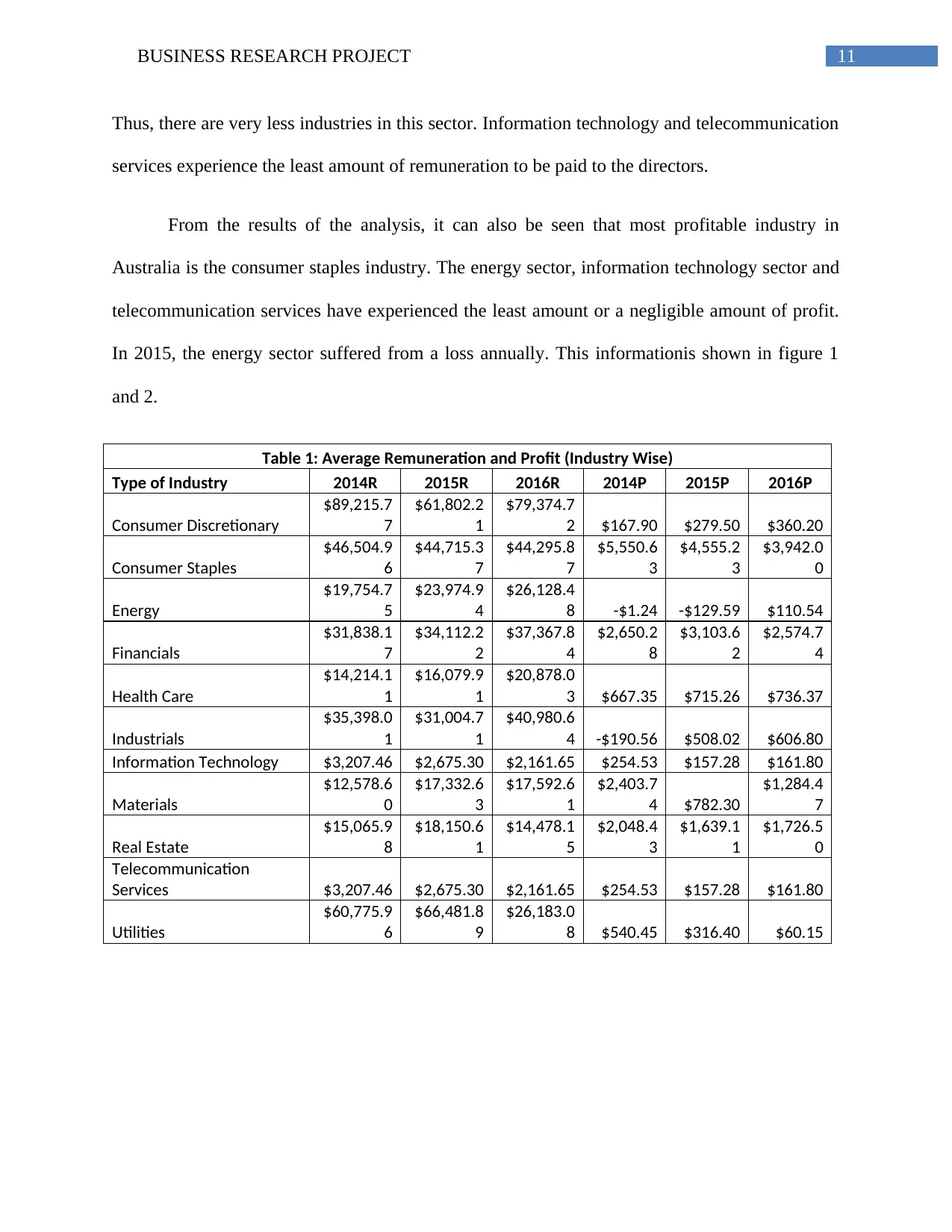
11BUSINESS RESEARCH PROJECT
Thus, there are very less industries in this sector. Information technology and telecommunication
services experience the least amount of remuneration to be paid to the directors.
From the results of the analysis, it can also be seen that most profitable industry in
Australia is the consumer staples industry. The energy sector, information technology sector and
telecommunication services have experienced the least amount or a negligible amount of profit.
In 2015, the energy sector suffered from a loss annually. This informationis shown in figure 1
and 2.
Table 1: Average Remuneration and Profit (Industry Wise)
Type of Industry 2014R 2015R 2016R 2014P 2015P 2016P
Consumer Discretionary
$89,215.7
7
$61,802.2
1
$79,374.7
2 $167.90 $279.50 $360.20
Consumer Staples
$46,504.9
6
$44,715.3
7
$44,295.8
7
$5,550.6
3
$4,555.2
3
$3,942.0
0
Energy
$19,754.7
5
$23,974.9
4
$26,128.4
8 -$1.24 -$129.59 $110.54
Financials
$31,838.1
7
$34,112.2
2
$37,367.8
4
$2,650.2
8
$3,103.6
2
$2,574.7
4
Health Care
$14,214.1
1
$16,079.9
1
$20,878.0
3 $667.35 $715.26 $736.37
Industrials
$35,398.0
1
$31,004.7
1
$40,980.6
4 -$190.56 $508.02 $606.80
Information Technology $3,207.46 $2,675.30 $2,161.65 $254.53 $157.28 $161.80
Materials
$12,578.6
0
$17,332.6
3
$17,592.6
1
$2,403.7
4 $782.30
$1,284.4
7
Real Estate
$15,065.9
8
$18,150.6
1
$14,478.1
5
$2,048.4
3
$1,639.1
1
$1,726.5
0
Telecommunication
Services $3,207.46 $2,675.30 $2,161.65 $254.53 $157.28 $161.80
Utilities
$60,775.9
6
$66,481.8
9
$26,183.0
8 $540.45 $316.40 $60.15
Thus, there are very less industries in this sector. Information technology and telecommunication
services experience the least amount of remuneration to be paid to the directors.
From the results of the analysis, it can also be seen that most profitable industry in
Australia is the consumer staples industry. The energy sector, information technology sector and
telecommunication services have experienced the least amount or a negligible amount of profit.
In 2015, the energy sector suffered from a loss annually. This informationis shown in figure 1
and 2.
Table 1: Average Remuneration and Profit (Industry Wise)
Type of Industry 2014R 2015R 2016R 2014P 2015P 2016P
Consumer Discretionary
$89,215.7
7
$61,802.2
1
$79,374.7
2 $167.90 $279.50 $360.20
Consumer Staples
$46,504.9
6
$44,715.3
7
$44,295.8
7
$5,550.6
3
$4,555.2
3
$3,942.0
0
Energy
$19,754.7
5
$23,974.9
4
$26,128.4
8 -$1.24 -$129.59 $110.54
Financials
$31,838.1
7
$34,112.2
2
$37,367.8
4
$2,650.2
8
$3,103.6
2
$2,574.7
4
Health Care
$14,214.1
1
$16,079.9
1
$20,878.0
3 $667.35 $715.26 $736.37
Industrials
$35,398.0
1
$31,004.7
1
$40,980.6
4 -$190.56 $508.02 $606.80
Information Technology $3,207.46 $2,675.30 $2,161.65 $254.53 $157.28 $161.80
Materials
$12,578.6
0
$17,332.6
3
$17,592.6
1
$2,403.7
4 $782.30
$1,284.4
7
Real Estate
$15,065.9
8
$18,150.6
1
$14,478.1
5
$2,048.4
3
$1,639.1
1
$1,726.5
0
Telecommunication
Services $3,207.46 $2,675.30 $2,161.65 $254.53 $157.28 $161.80
Utilities
$60,775.9
6
$66,481.8
9
$26,183.0
8 $540.45 $316.40 $60.15
⊘ This is a preview!⊘
Do you want full access?
Subscribe today to unlock all pages.

Trusted by 1+ million students worldwide
1 out of 22
Related Documents
Your All-in-One AI-Powered Toolkit for Academic Success.
+13062052269
info@desklib.com
Available 24*7 on WhatsApp / Email
![[object Object]](/_next/static/media/star-bottom.7253800d.svg)
Unlock your academic potential
Copyright © 2020–2025 A2Z Services. All Rights Reserved. Developed and managed by ZUCOL.





